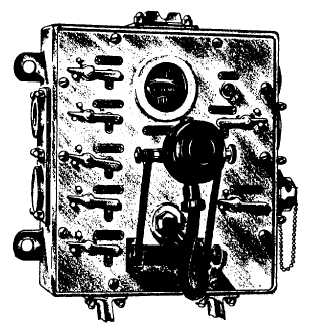| |
concerned. It connects the bridge and other conning
stations with main engine control, steering aft, and other
emergency steering stations. It has outlets on the main
deck for control of the anchor detail and line-handling
parties fore and aft. This circuit is always manned by
CIC, and may be manned by other control stations when
advisable. The conning officer controls the 1JV, and the
circuit is always manned-or at least is ready for instant
use-whenever the ship is underway.
The JW is the navigator's circuit by which
Quartermasters stationed at peloruses may report
directly to the navigator at the chart table. During
piloting, the JW is connected with communication
spaces.
The JZ circuit is the damage control circuit by
which damage control parties can communicate with
DC Central.
Some of the foregoing circuits may vary slightly on
different ships. As soon as you report aboard a new ship
for duty, you must learn the details of any possible
variance.
AUXILIARY BATTLE CIRCUITS
The auxiliary battle circuits form a secondary
system, consisting of sound-powered lines that are not
routed through a switchboard. Most of the important
circuits described previously have substitutes in the
auxiliary system.
An auxiliary circuit is designated by the letter X,
followed by the symbol of the circuit for which it is a
substitute. Many circuits are equipped with call buzzers
so that communication can be maintained with stations
on the circuit without the circuits having to be manned
continuously. A typical example is the X1JV, which
permits the OOD to exchange communications directly
with the engineering officer of the watch.
VOICE TUBE
On most mine craft, patrol boats, and the like, the
voice tube still is the primary means of interior
communications, although some small craft have
sound-powered-phone circuits. A voice tube requires
neither electrical nor sound power, but its effectiveness
decreases, of course, in direct ratio to the length of the
tube and number of bends it contains. On large ships,
communication by voice tube is for short distances only,
as between open conning stations and the pilothouse.
SHIPBOARD ANNOUNCING SYSTEMS
In the old Navy, before the days of loudspeaker
systems, an all-hands order was passed by word of
mouth by the Boatswain's Mates fore and aft. The
boatswain or BM of the watch sounded “CALL
MATES” on his pipe to get the BMs together, and they
answered repeatedly with the same call from various
parts of the ship as they converged on the bridge or
quarterdeck. When they heard the word, they dispersed
fore and aft to sing it out at every hatch.
This procedure was very colorful, but it took a lot
of time. Now, a single Boatswain's Mate can pass the
word over the MC circuit in short order, while the others
stay where they are, keeping the gang heaving around.
The basic MC circuit is the 1MC, the general
announcing system, over which word can be passed to
every space in the ship. The general alarm system is tied
into it as well. Transmitters are located on the bridge,
quarterdeck, and central station; and additional
transmitters may be at other points. See figure 2-18.
The OOD is in charge of the 1MC. Except for
possibly an emergency call by the damage control
officer, no call may be passed over the 1MC unless
authorized by the OOD, the executive officer, or the
captain.
Normally, the 1MC is equipped with switches that
make it possible for certain spaces to be cut off from
announcements of no concern to them. The captain, for
Figure 2-18.— loudspeaker transmitter.
2-17
|

